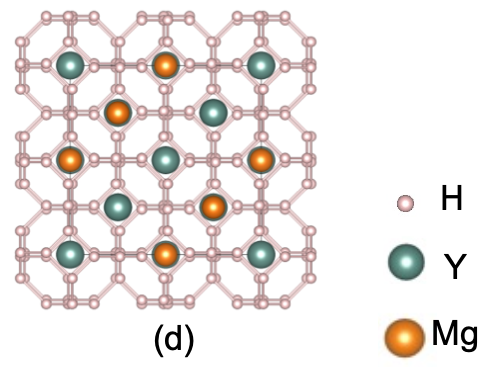Superconductor Simulations: Algorithms Predict Superconductivity in Crystalline Materials
Using computer simulations, Japanese researchers predict new crystal structures as potential candidates for high-temperature superconductors
Superconductivity is a phenomenon where a material loses its electrical resistance. However, it occurs at extremely low transition temperatures requiring expensive cooling solutions. A breakthrough in high-temperature superconductors was found in crystal structures containing hydrogen. Now, researchers have used a supercomputer to predict new candidates among such hydrogen-containing crystalline materials. Their simulations reveal certain structures to display superconductivity getting closer to room temperature.
High-temperature superconductivity allows the development of energy-efficient devices without the need for expensive cooling solutions. In this regard, ternary hydrides, which are compounds formed by two elements and hydrogen have displayed superconductivity at room temperatures, although at extremely high pressures. However, finding the right set of elements that result in a superconducting ternary hydride can be a daunting task due to the sheer number of possible combinations with metals and non-metals.
Now in a study published in Advanced Theory and Simulations, Associate Professor Kenta Hongo, Professor Ryo Maezono and Assistant Professor Kousuke Nakano from Japan Advanced Institute of Science and Technology (JAIST) have used a supercomputer to successfully determine the likely candidates for stable ternary hydrides that exhibit room-temperature superconductivity.
Among ternary metal hydrides, low atomic number elements attached to binary yttrium hydride systems (YHx) have been observed to be stable compounds with high transition temperatures. Magnesium in particular, when attached to hydrogen as a binary hydride (MgH6) has displayed room temperature superconductivity. The favorable transition temperature and stability at high pressures encouraged the researchers to focus their search on Y-Mg-H systems.
Apart from having a high transition temperature, a viable candidate has to be stable at the high pressures where superconductivity is observed. Using this parameter in their search, the researchers examined possible crystal structures for YMgHx compounds where (x= 2-10, 12,14, 16). Starting from random structures, they analyzed various configurations for each hydrogen composition (x value) until they found the most stable structures at high pressures of 100, 200 and 300 GPa.
The search revealed certain configurations to have symmetric clathrate structures with cage-like structures of hydrogen atoms stacked on top of each other. These are highly stable structures and viable candidates for high-temperature superconductors. The hydrogen content was found to play a key role in the superconductivity phenomena. On predicting the transition temperatures of these clathrate structures, the researchers found that the structures with a higher number of hydrogen atoms had a higher transition temperature (Tc). "These H-rich phases are high-Tc materials; therefore, the hydrogen content of x = 6 is very integral and the clathrate structures are key to discovering high Tc materials," says Prof. Maezono. Among all the candidate structures, the researchers found the stable Cmmm-YMgH12 and the metastable -YMgH12 structure to meet both the criteria of high stability and high transition temperature (153 K and 190 K respectively).
In addition to finding viable high-temperature superconducting candidates, the simulations revealed the importance of various factors that contribute to the superconducting phenomena, clarifying many of the requirements for valid structures, enabling future discoveries to be made. "Using ab initio simulations combined with data science, we can speed up the development of materials and realize high energy efficiency via superconducting phenomena," says Prof. Hongo.
With the aid of computer simulations, researchers are beginning to understand the factors that lead to superconductivity. It is only a matter of time before we experience the energy revolution brought about by this much sought-after phenomenon.

Figure 1. Clathrate structure of -YMgH12
Newly discovered crystal structure of the superconductor realizing higher transition temperature. It is composed of a cage structure unit.
Image credit: Kenta Hongo from JAIST
Reference
| Title of original paper: | The Systematic Study on the Stability and Superconductivity of Y-Mg-H Compounds under High Pressure |
| Journal: | Advanced Theory and Simulations |
| DOI: | 10.1002/adts.202100364 |
Funding information
The computations in this work were performed using the facilities of Research Center for Advanced Computing Infrastructure (RCACI) at JAIST.
Dr. Ryo Maezono is grateful for financial supports from MEXT-KAKENHI (JP16KK0097, JP19H04692, and JP21K03400), FLAGSHIP2020 (project nos. hp190169 and hp190167 at K-computer), the Air Force Office of Scientific Research (AFOSR-AOARD/FA2386-17-1-4049; FA2386-19-1-4015), and JSPS Bilateral Joint Projects (with India DST).
Dr. Kenta Hongo is grateful for financial support from the HPCI System Research Project (Project ID: hp210019, hp210131, and jh210045), MEXT-KAKENHI (JP16H06439, JP17K17762, JP19K05029, JP19H05169, and JP21K03400), and the Air Force Office of Scientific Research (Award Numbers: FA2386-20-1-4036).
January 31, 2022
